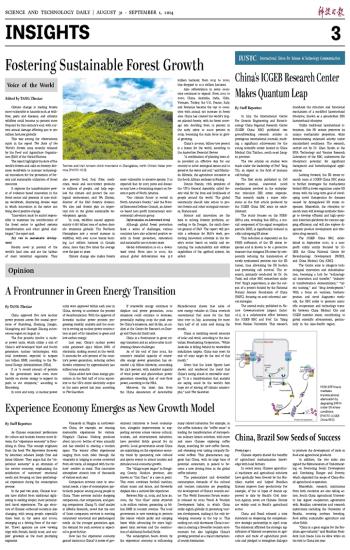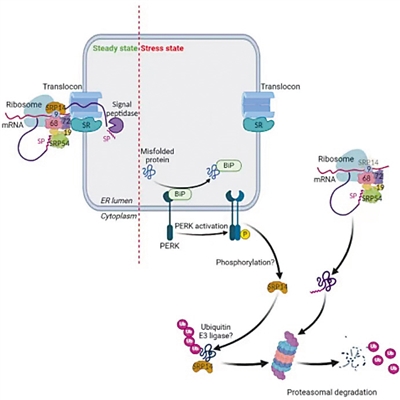
 |
| PERK-SRP14 axis mediates translocational attenuation by degrading SRP14 under ER stress conditions. (PHOTO: ICGEB China RRC) |
In July, the International Centre For Genetic Engineering and Biotechnology China Regional Research Centre (ICGEB China RRC) published two groundbreaking research articles in prestigious international journals, marking a significant achievement for the young scientific center located in China Medical City, Taizhou, south coast Jiangsu province.
The two articles on studies were made under the leadership of Prof. Yang Yili, an expert in the field of immune cell biology.
The first study, published in Cell Reports journal, uncovered novel mechanisms involved in the endoplasmic reticulum (ER) stress response. This research marks a major milestone as the first article produced by the ICGEB China RRC since its establishment.
The study focuses on the PERK-SRP14 axis, revealing that SRP14, a crucial component of the signal recognition particle (SRP), is significantly reduced in cells undergoing ER stress.
This reduction is dependent on the PRKR subbranch of the ER stress response and is shown to be a protective measure that mitigates ER stress by temporarily reducing the translocation of newly synthesized proteins into the ER lumen, thus alleviating the ER burden and promoting cell survival. The research, primarily conducted by Dr. Gu Yuexi and other RRC researchers under Prof. Yang's supervision, is also the output of a project funded by the National Natural Science Foundation of China (NSFC), focusing on anti-colorectal cancer strategies.
The second study, published in Nature Communications (impact factor: 16.1), is a collaborative effort between the ICGEB RRC and Prof. Liu Yijing from Nankai University. This research elucidates the structure and functional mechanism of a modified hammerhead ribozyme, known as a pseudoknot (PK) hammerhead ribozyme.
Unlike traditional hammerhead ribozymes, this PK variant preserves its unique mechanistic properties, while demonstrating enhanced activity under standardized conditions. The research, carried out by Dr. Zhan Xuelin at the RNA Technology and Vaccine Research Laboratory of the RRC, underscores the ribozyme's potential for significant therapeutic and biotechnological applications.
Looking forward, the ER stress research team at ICGEB China RRC plans to further investigate the mechanisms behind SRP14 down-regulation under ER stress, with the long-term goal of developing novel therapeutics for diseases caused by dysregulated ER stress responses. Meanwhile, the ribozyme research team will leverage synthetic biology to develop efficient and high-precision detection platforms for vaccine capping efficiency, and will also explore diagnostic product development and ribozyme drug research.
The ICGEB China RRC, established in September 2020, is a non-profit entity jointly founded by ICGEB, the China National Centre for Biotechnology Development (NCBD), and China Medical City (CMC).
The Centre aims to integrate technological innovation and industrialization, becoming a hub for "technological innovation and transfer," "industrial transformation demonstration," "talent training," and "drug development." With a focus on vaccines, biotherapeutics, and novel diagnostic methods, the RRC seeks to promote scientific cooperation and technology transfer between China Medical City and ICGEB member states, contributing to global scientific advancement, particularly in the Asia-Pacific region.


 Next
Next




